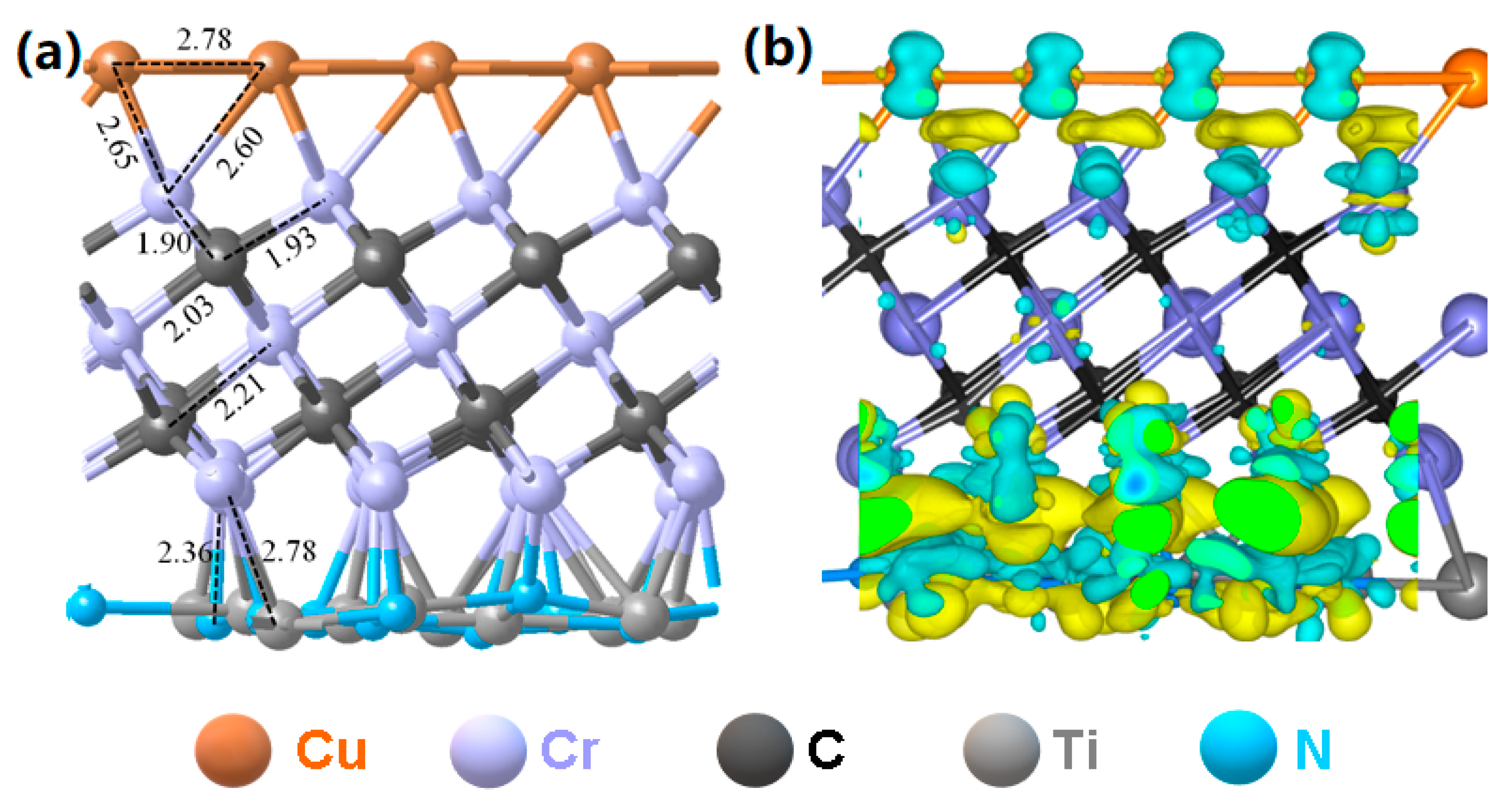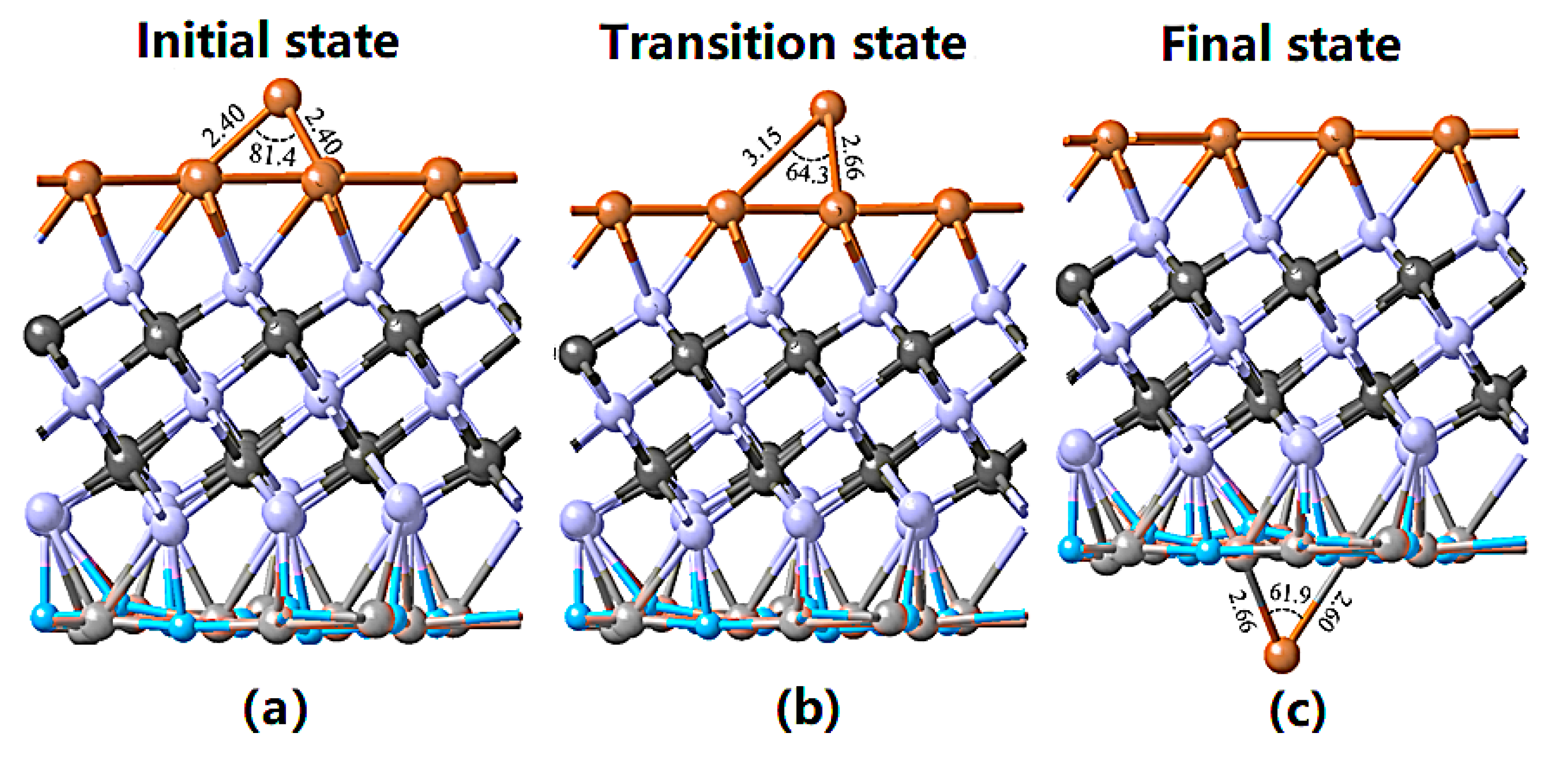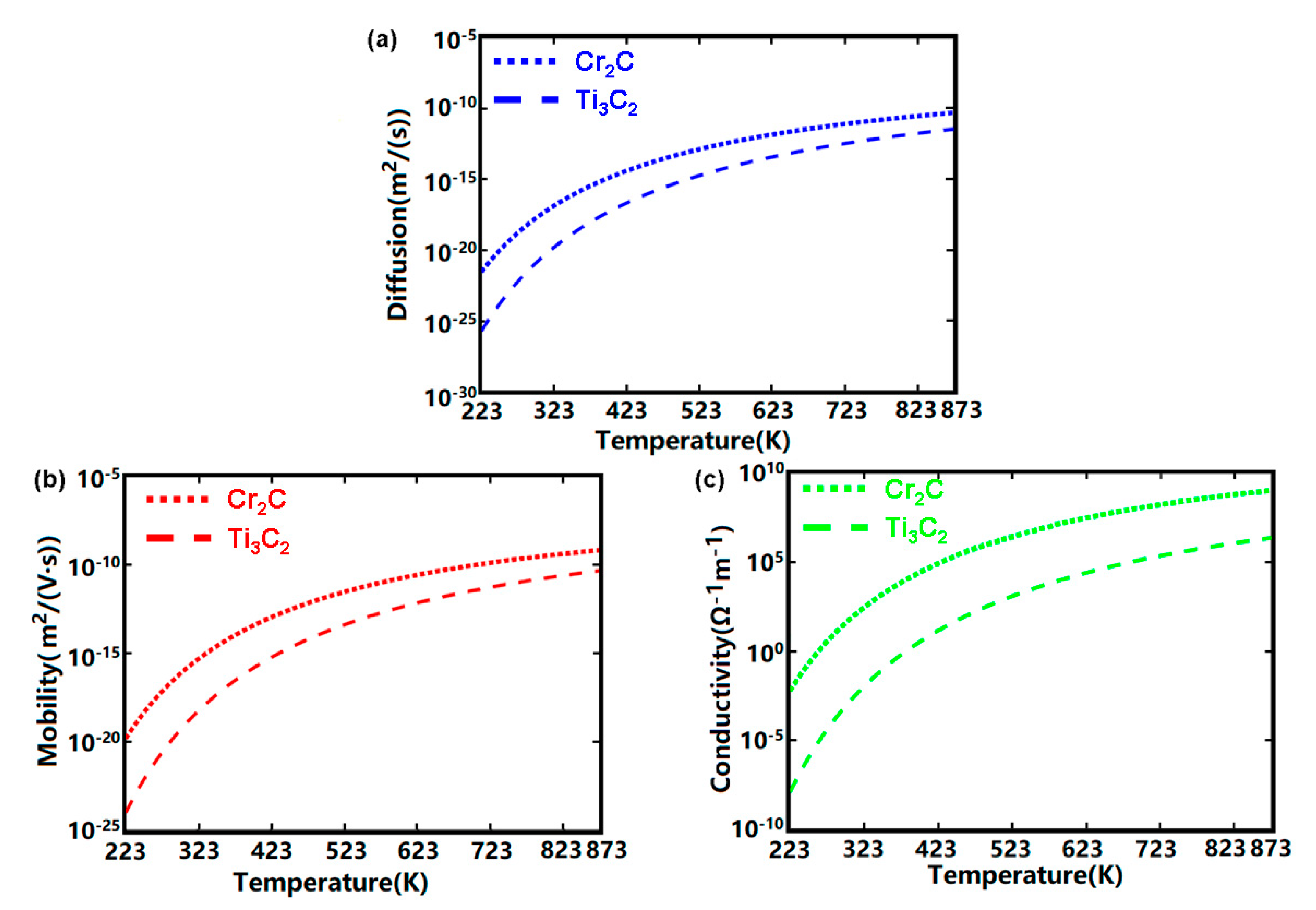Electrical Conduction Characteristic of a 2D MXene Device with Cu/Cr2C/TiN Structure Based on Density Functional Theory
Abstract
:1. Introduction
2. Methods
3. Results and Discussion
4. Conclusions
Author Contributions
Funding
Conflicts of Interest
References
- Zhang, H. Ultrathin Two-Dimensional Nanomaterials. ACS Nano 2015, 9, 9451–9469. [Google Scholar] [CrossRef]
- Anasori, B.; Lukatskaya, M.R.; Gogotsi, Y. 2D Metal Carbides and Nitrides (MXenes) for Energy Storage. Nat. Rev. Mater. 2017, 2, 16098. [Google Scholar] [CrossRef]
- Anasori, B.; Xie, Y.; Beidaghhi, M.; Lu, J.; Hosler, B.C.; Hultman, L.; Kennt, P.R.C.; Gogotsi, Y.; Barsoum, M.W. Two-Dimensional, Ordered, Double Transition Metals Carbides (MXenes). ACS Nano 2015, 9, 9507–9516. [Google Scholar] [CrossRef] [PubMed]
- Jiang, X.; Kuklin, A.; Baev, A.; Ge, Y.; Agren, H.; Zhang, H.; Prasad, P. Two-Dimensional Mxenes: From Morphological to Optical, Electric, and Magnetic Properties and Applications. Phys. Rep. 2020, 848, 1–58. [Google Scholar] [CrossRef]
- Meshkian, R.; Tao, Q.; Dahiqvist, M.; Lu, J.; Hultman, L.; Rosen, J. Theoretical Stability and Materials Synthesis of a Chemically Ordered MAX Phase, Mo2ScAlC2, and Its Two-Dimensional Derivate Mo2ScC2 MXene. Acta Mater. 2017, 125, 476–480. [Google Scholar] [CrossRef] [Green Version]
- Mishra, A.; Srivastava, P.; Mizuseki, H.; Lee, K.R.; Singh, A.K. Isolation of Pristine MXene from Nb4AlC3 MAX Phase: A First-Principles Study. Phys. Chem. Chem. Phys. 2016, 18, 11073–11080. [Google Scholar] [CrossRef] [PubMed]
- Shao, B.B.; Liu, Z.F.; Zeng, G.M.; Wang, H.; Liang, Q.H.; He, Q.Y.; Cheng, M.; Zhou, C.Y.; Jiang, L.B.; Song, B. Two-Dimensional Transition Metal Carbide and Nitride (MXene) Derived Quantum Dots (QDs): Synthesis, Properties, Applications and Prospects. J. Mater. Chem. A 2020, 8, 7508–7535. [Google Scholar] [CrossRef]
- Naguib, M.; Kurtoglu, M.; Presser, V.; Lu, J.; Niu, J.; Heon, M.; Hultman, L.; Gogotsi, Y.; Barsoum, M.W. Two-Dimensional Nanocrystals Produced by Exfoliation of Ti3AlC2. Adv. Mater. 2011, 23, 4248–4253. [Google Scholar] [CrossRef] [Green Version]
- Sun, W.; Shah, S.; Chen, Y.; Tan, Z.; Gao, H.; Habib, T.; Radovic, M.; Green, M. Electrochemical Etching of Ti2AlC to Ti2CTx (MXene) in Low-Concentration Hydrochloric Acid Solution. J. Mater. Chem. A 2017, 5, 21663–21668. [Google Scholar] [CrossRef]
- Li, M.; Lu, J.; Luo, K.; Li, Y.; Chang, K.; Chen, K.; Zhou, J.; Rosen, J.; Hultman, L.; Eklund, P.; et al. An Element Replacement Approach by Reaction with Lewis Acidic Molten Salts to Synthesize Nanolaminated MAX Phases and Mxenes. J. Am. Chem. Soc. 2019, 141, 4730–4737. [Google Scholar] [CrossRef] [Green Version]
- Sarycheva, A.; Polemi, A.; Liu, Y.; Dandekar, K.; Anasori, B.; Gogotsi, Y. 2D Titanium Carbide (Mxene) for Wireless Communication. Sci. Adv. 2018, 4, eaau0920. [Google Scholar] [CrossRef] [PubMed] [Green Version]
- Cao, M.S.; Cai, Y.Z.; He, P.; Shu, J.C.; Cao, W.Q.; Yuan, J. 2D MXenes: Electromagnetic Property for Microwave Absorption and Electromagnetic Interference Shielding. Chem. Eng. J. 2019, 359, 1265–1302. [Google Scholar] [CrossRef]
- Pang, J.B.; Mendes, R.G.; Bachmatiuk, A.; Zhao, L.; Ta, H.Q.; Gemming, T.; Liu, H.; Liu, Z.F.; Rummeli, H. Applications of 2D MXenes in Energy Conversion and Storage Systems. Chem. Soc. Rev. 2019, 48, 72–133. [Google Scholar] [CrossRef] [PubMed]
- Liu, H.; Duan, C.Y.; Yang, C.H.; Shen, W.Q.; Wang, F.; Zhu, Z.F. A Novel Nitrite Biosensor Based on the Direct Electrochemistry of Hemoglobin Immobilized on MXene-Ti3C2. Sens. Actuators B-Chem. 2015, 218, 60–66. [Google Scholar] [CrossRef]
- Choi, G.; Shahzad, F.; Bahk, Y.M.; Jhon, Y.M.; Park, H.; Alhabeb, M.; Anasori, B.; Kim, D.S.; Koo, C.M.; Gogotsi, Y.; et al. Enhanced Terahertz Shielding of MXenes with Nano-Metamaterials. Adv. Opt. Mater. 2018, 6, 1701076. [Google Scholar] [CrossRef]
- Weng, H.M.; Ranjbar, A.; Liang, Y.Y.; Song, Z.D.; Khazaei, M.; Yunoki, S.; Arai, M.; Kawazoe, Y.; Fang, Z.; Dai, X. Large-Gap Two-Dimensional Topological Insulator in Oxygen Functionalized MXene. Phys. Rev. B 2015, 92, 075436. [Google Scholar] [CrossRef] [Green Version]
- Gismatulin, A.A.; Orlov, O.M.; Gritsenko, V.A.; Kruchinin, V.N.; Mizginov, D.S.; Krasnikov, G.Y. Charge Transport Mechanism in the Metal-Nitride-Oxide-Silicon Forming-Free Memristor Structure. Appl. Phys. Lett. 2020, 116, 203502. [Google Scholar]
- Gonzalez-Rosillo, J.C.; Cataalano, S.; Maggio-Aprile, I.; Gibert, M.; Obradors, X.; Palau, A.; Puig, T. Nanoscale Correlations between Metal-Insulator Transition and Resistive Switching Effect in Metallic Perovskite Oxides. Small 2020, 16, 2001307. [Google Scholar] [CrossRef]
- Yin, X.; Wang, Y.Z.; Chang, T.H.; Zhang, P.; Li, J.; Xue, P.P.; Long, Y.; Shohet, J.L.; Voyles, P.M.; Ma, Z.Q.; et al. Memristive Behavior Enabled by Amorphous-Crystalline 2D Oxide Heterostructure. Adv. Mater. 2020, 32, 20000801. [Google Scholar] [CrossRef]
- Chua, L. Memristor—The Missing Circuit Element. IEEE Trans. Circuit Theory 1971, 18, 507–519. [Google Scholar] [CrossRef]
- Strukov, D.B.; Snider, G.S.; Stewart, D.R.; Williams, R.S. The Missing Memristor Found. Nature 2008, 453, 80–83. [Google Scholar] [CrossRef]
- Yang, J.J.; Pickett, M.D.; Li, X.M.; Ohlberg, D.A.A.; Stewart, D.R.; Williams, R.S. Memristive Switching Mechanism for Metal/Oxide/Metal Nanodevices. Nat. Nanotechnol. 2008, 3, 429–433. [Google Scholar] [CrossRef] [PubMed]
- Yang, Y.C.; Gao, P.; Gaba, S.; Chang, T.; Pan, X.; Lu, W. Observation of Conducting Filament Growth in Nanoscale Resistive Memories. Nat. Commun. 2012, 13, 732. [Google Scholar] [CrossRef]
- Wang, T.Y.; Meng, J.L.; Rao, M.Y.; He, Z.Y.; Chen, L.; Zhu, H.; Sun, Q.Q.; Ding, S.J.; Bao, W.Z.; Zhou, P. Three-Dimensional Nanoscale Flexible Memristor Networks with Ultralow Power for Information Transmission and Processing Application. Nano Lett. 2020, 20, 4111–4120. [Google Scholar] [CrossRef] [PubMed]
- Xiao, X.Y.; Hu, J.; Tang, S.; Yan, K.; Gao, B.; Chen, H.L.; Zou, D.C. Recent Advances in Halide Perovskite Memristors: Materials, Structures, Mechanisms, and Applications. Adv. Mater. Technol. 2020, 5, 1900914. [Google Scholar] [CrossRef]
- Guo, Y.Y.; Hu, W.; Zhang, C.G.; Penng, Y.; Guo, Y.C. An Electronic Synapse Device based on Aluminum Nitride Memristor for Neuromorphic Computing Application. J. Phys. D-Appl. Phys. 2020, 53, 195101. [Google Scholar] [CrossRef]
- Wang, Y.Q.; Liu, X.W.; Chen, Y.H.; Xu, W.; Liang, D.K.; Gao, F.; Zhang, M.C.; Samanta, S.; Gong, X.; Lian, X.J.; et al. Manipulation of The Electrical Behaviors of Cu/MXene/SiO2/W Memristor. Appl. Phys. Express 2019, 12, 106504. [Google Scholar] [CrossRef]
- Lian, X.; Shen, X.; Zhang, M.; Xu, J.; Gao, F.; Wan, X.; Hu, E.; Guo, Y.; Zhao, J.; Tong, Y. Resistance Switching Characteristics and Mechanisms of MXene/SiO2 Structure-based Memristor. Appl. Phys. Lett. 2019, 115, 063901. [Google Scholar] [CrossRef]
- Kresse, G.; Furthmuller, J. Efficient Iterative Schemes for ab initio Total-Energy Calculations Using a Plane-Wave Basis Set. Comput. Mater. Sci. 1996, 6, 15–50. [Google Scholar] [CrossRef]
- MedeA® Is a Registered Trademark of Materials Design, Inc., Santa Fe, New Mexico, USA, 2013. Available online: https://materialsdesign.com/products (accessed on 6 July 2020).
- Kresse, G.; Joubert, D. From Ultrasoft Pseudopotentials to the Projector Augmented-Wave Method. Phys. Rev. B 1999, 56, 1758–1775. [Google Scholar] [CrossRef]
- Blochl, P.E. Projector Augmented-Wave Method. Phys. Rev. B 1994, 50, 17953–17979. [Google Scholar] [CrossRef] [Green Version]
- Perdew, J.P.; Burke, K.; Eunzerhof, M. Generalized Gradient Approximation Made Simple. Phys. Rev. Lett. 1996, 77, 3865–3868. [Google Scholar] [CrossRef] [PubMed] [Green Version]
- Perdew, J.P.; Ruzsinszky, A.; Csonka, G.I.; Vydrov, O.A.; Scuseria, G.E.; Constantin, L.A.; Zhou, X.L.; Burke, K. Restoring The Density-Gradient Expansion for Exchange in Solids and Surfaces. Phys. Rev. Lett. 2008, 100, 136406. [Google Scholar] [CrossRef] [PubMed] [Green Version]
- Liu, X.B.A.; Shao, X.F.; Li, F.; Zhao, M.W. Anchoring Effects of S-Terminated Ti2C MXene for Lithium-Sulfur Batteries: A First-Principles Study. Appl. Surf. Sci. 2018, 455, 522–526. [Google Scholar] [CrossRef]
- Berdiyorov, G.R. Optical Properties of Functionalized Ti3C2T2 (T = F, O, OH) MXene: First-Principles Calculations. AIP. Adv. 2016, 6, 055105. [Google Scholar] [CrossRef] [Green Version]
- Jonsson, H.; Mills, G.; Jacobsen, K.W. Nudged Elastic Band Method for Finding Minimum Energy Paths of Transitions; World Scientific: Singapore, 1998. [Google Scholar]
- Monkhorst, H.J.; Pack, J.D. Special Points for Brillouin-Zone Integrations. Phys. Rev. B 1976, 13, 5188–5192. [Google Scholar] [CrossRef]
- Yadav, A.; Dashora, A.; Patel, N.; Miotello, A.; Press, M.; Kothari, D.C. Study of 2D MXene Cr2C Material for Hydrogen Storage Using Density Functional Theory. Appl. Surf. Sci. 2016, 389, 88–95. [Google Scholar] [CrossRef]
- Li, H.; Wang, X.; Zhang, T.; Gong, X.; Sun, Q.; Pan, H.; Shen, Y.; Ahmad, S.; Wang, M. Layered Ruddlesden-Popper Efficient Perovskite Solar Cells with Controlled Quantum and Dielectric Confinement Introduced via Doping. Adv. Funct. Mater. 2019. [Google Scholar] [CrossRef]
- Li, B.; Guo, H.; Wang, Y.; Zhang, W.; Zhang, Q.; Chen, L.; Fan, X.; Zhang, W.; Li, Y.; Lau, W. Asymmetric MXene/Monolayer Transition Metal Dichalcogenide Heterostructures for Functional Applications. npj Comp. Mater. 2019, 5, 16–25. [Google Scholar] [CrossRef]





© 2020 by the authors. Licensee MDPI, Basel, Switzerland. This article is an open access article distributed under the terms and conditions of the Creative Commons Attribution (CC BY) license (http://creativecommons.org/licenses/by/4.0/).
Share and Cite
Wang, L.; Wen, J.; Jiang, Y.; Ou, Q.; Yu, L.; Xiong, B.-S.; Yang, B.; Zhang, C.; Tong, Y. Electrical Conduction Characteristic of a 2D MXene Device with Cu/Cr2C/TiN Structure Based on Density Functional Theory. Materials 2020, 13, 3671. https://doi.org/10.3390/ma13173671
Wang L, Wen J, Jiang Y, Ou Q, Yu L, Xiong B-S, Yang B, Zhang C, Tong Y. Electrical Conduction Characteristic of a 2D MXene Device with Cu/Cr2C/TiN Structure Based on Density Functional Theory. Materials. 2020; 13(17):3671. https://doi.org/10.3390/ma13173671
Chicago/Turabian StyleWang, Lei, Jing Wen, Yuan Jiang, Qiaofeng Ou, Lei Yu, Bang-Shu Xiong, Bingxing Yang, Chao Zhang, and Yi Tong. 2020. "Electrical Conduction Characteristic of a 2D MXene Device with Cu/Cr2C/TiN Structure Based on Density Functional Theory" Materials 13, no. 17: 3671. https://doi.org/10.3390/ma13173671
APA StyleWang, L., Wen, J., Jiang, Y., Ou, Q., Yu, L., Xiong, B.-S., Yang, B., Zhang, C., & Tong, Y. (2020). Electrical Conduction Characteristic of a 2D MXene Device with Cu/Cr2C/TiN Structure Based on Density Functional Theory. Materials, 13(17), 3671. https://doi.org/10.3390/ma13173671



